6.1 Installation on NetWare and Windows Servers
If you are installing only to workstations, go to Section 6.2, Installation on Windows Workstations.
The following sections provide instructions for installing Policy-Enabled Server Management to NetWare or Windows servers:
6.1.1 Policy-Enabled Server Management
To install Policy-Enabled Server Management, do the following in order:
Pre-Installation Checklist
-
Review the Readme for any last-minute information concerning installation.
Readme_servers.html is located in the \readmes\en directory on the Novell ZENworks 7 Server Management with Support Pack 1 Program CD, and is also accessible from an installation menu option.
-
Make sure you have fulfilled all of the installation requirements in Section II, Preparation.
If you are also installing Policy and Distribution Services remotely to workstations, the target workstations must have one of the following Windows operating systems installed:
- Windows 2000 SP4 or later
- Windows XP SP1 or later
The Novell Client™ is not required to be installed or running on workstations where you install to them remotely.
-
To install from a hard drive instead of the Program CD, copy the CD structure to a location on your installation machine’s hard drive.
We recommend that you install Server Management from the Program CD.
IMPORTANT:If you copy the Program CD structure to the installation machine’s hard drive, the path between the root of the hard drive and the first CD directory can contain only directory names that conform to the 8.3-character DOS file naming convention. If any long directory names exist in the path, the installation program does not work.
-
If you are reinstalling Server Inventory, you must perform the following tasks before reinstalling:
1. Identify the servers that need Server Inventory reinstalled.
2. Stop the Inventory service.
-
On a NetWare Inventory server: At the server console prompt, enter:
sys:\system\invstop.ncf
NOTE:If you do not want the Sybase database to be stopped automatically when you stop the Inventory services, comment out the Unload dbsrv8.nlm line in the sys:\system\invstop.ncf file.
-
On a Windows 2000/2003 Inventory server: In the Control Panel, double-click > , right-click , then click .
3. Stop the Inventory database.
-
On NetWare: At the Sybase console prompt, press the Q key.
-
On Windows 2000/2003: In the Control Panel, double-click > , right-click , then click .
4. If Java has not been unloaded on the target NetWare servers, unload java.nlm (at the server console, enter java -exit).
Because this command stops all Java processes running on the server, verify that all Java processes can be stopped while you are installing Server Management.
-
-
If you have any instance of Novell ConsoleOne® running on a target server via a mapped drive from a workstation, or running from the installation machine, exit those instances of ConsoleOne before running the installation program.
If ConsoleOne is running on a target server via a mapped drive on your installation machine, or it is running from the installation machine, the ZENworks Server Management snap-ins for ConsoleOne fails to be installed at those locations.
-
On the workstation you use to install Server Management, if you have not already done so, log in to all eDirectory trees where you are installing the Server Management software.
Authentication: You are automatically authenticated to all of the target NetWare servers in the trees you are logged in to during installation, so that you can select those servers for installing the Server Management software.
Schema extension: You must extend the schema for ZENworks Server Management on one of these trees. Regardless of where a target server resides, its associated Distributor or Subscriber object is created in the tree where you extended the schema.
Inventory trees: Make sure that the eDirectory trees with servers where you want to install the Inventory server or the Inventory database components have the ZENworks Server Management schema extended prior to installing the Inventory software.
Also, if you want to install Proxy Service along with other Server Inventory or Policy and Distribution Services components to different servers residing on different eDirectory trees, log into the tree having the server where you want to install the other Server Inventory or the Policy and Distribution Services components.
-
If you install software to any Windows servers, make sure you have authenticated to the servers or a domain containing the servers.
This enables you to select Windows servers for installing the Distributor and Subscriber software. However, if you are not logged in to a Windows server before starting the installation, you can authenticate during installation using a username and password in the Add Server dialog box where you select the Windows server for installation.
-
If you install software to any Windows servers, make sure you have closed the Services window on each Windows server.
The installation program automatically stops all ZENworks Server Management services. However, the Server Management services cannot be registered if the Services window is left open during installation to the server.
-
If you are installing the Inventory server component, make sure that the name of the target server and the tree in which the server resides does not contain the # character.
Continue with Starting the Installation Program.
Starting the Installation Program
-
Do one of the following to display the main installation menu:
-
On the installation machine, insert the Novell ZENworks 7 Server Management with Support Pack 1 Program CD.
The main menu is displayed. If it is not automatically displayed after inserting the CD, run winsetup.exe at the root of the CD.
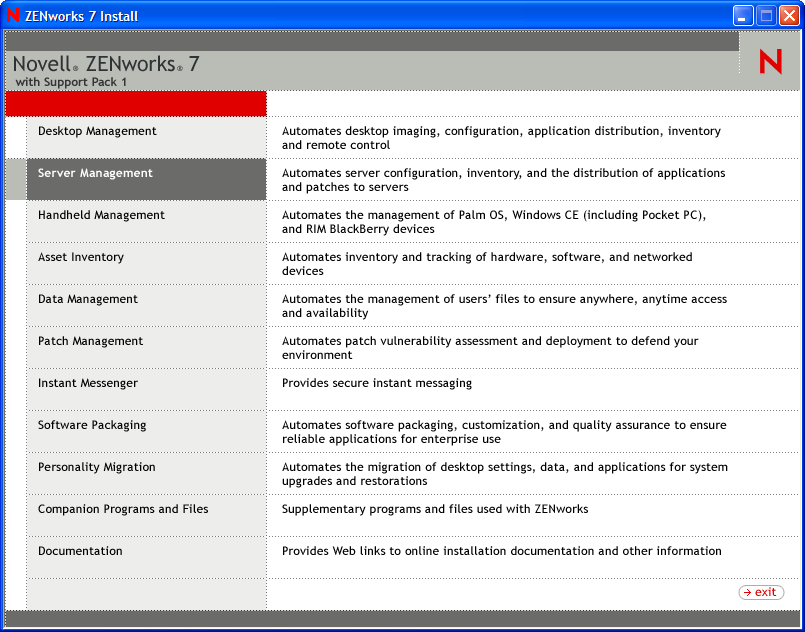
-
If you copied the contents of the Program CD to a hard drive, run winsetup.exe from that hard drive location.
IMPORTANT:If you copied the Program CD structure to the installation machine’s hard drive, the path between the root of the hard drive and the first CD directory can contain only directory names that conform to the 8.3-character DOS file naming convention. If any long directory names exist in the path, the installation program does not work.
-
-
Select the option.
-
Continue with Extending the Schema.
Extending the Schema
The schema must be extended on the eDirectory tree where you want to create the ZENworks objects.
You can also update a 90-day Evaluation License to a full license by identifying the tree where ZENworks objects have been created and entering a license code.
Figure 6-1 ZENworks Server Management Installation Menu
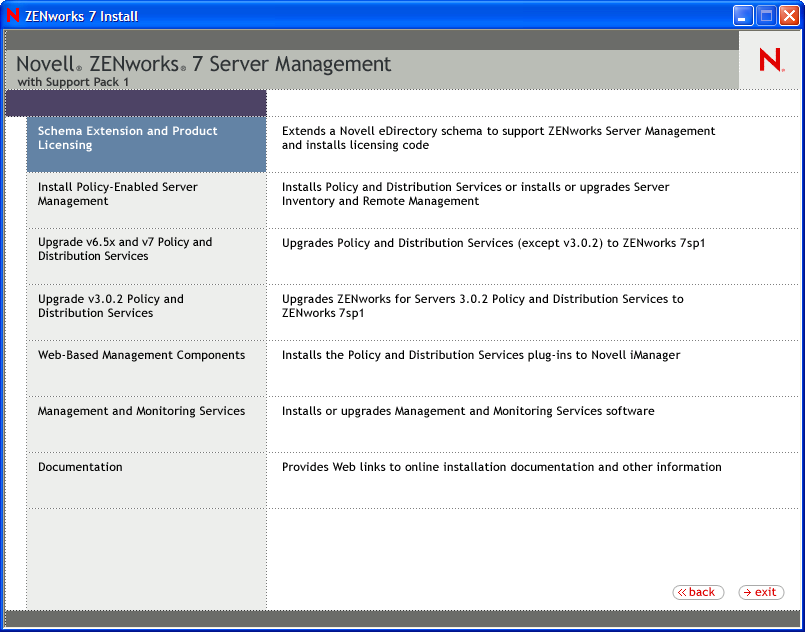
To extend the schema:
-
Select the option to display the ZENworks Server Management menu.
-
To extend the schema for ZENworks Server Management objects, click to display the ZENworks License Agreement page.
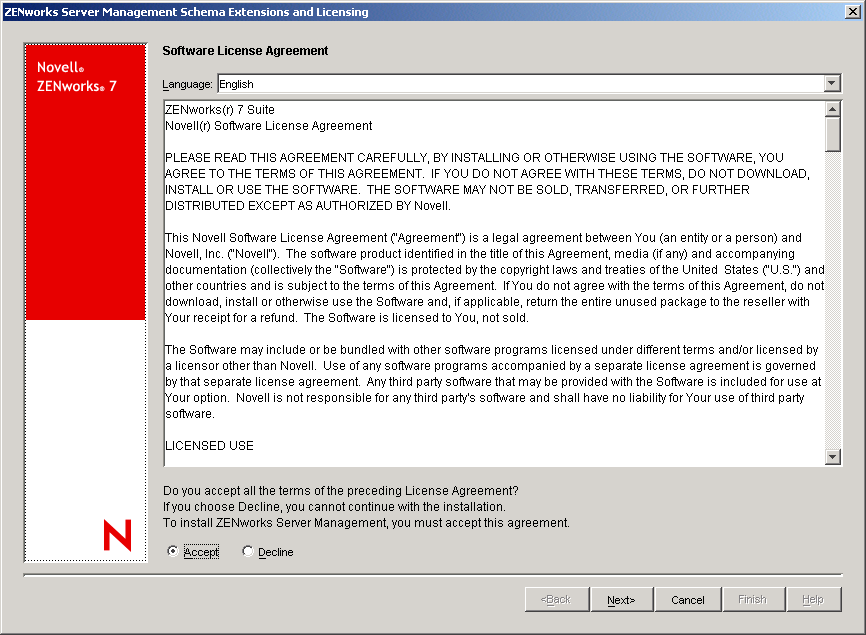
-
If you agree with the Software License Agreement, click > to display the eDirectory Tree for Creating Objects page; otherwise, click > to exit.
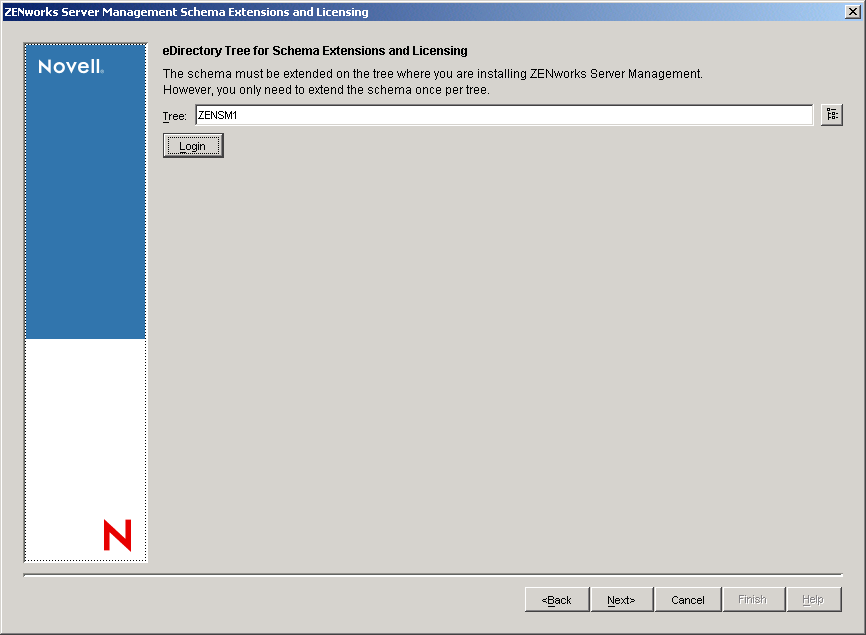
-
Select the tree where you want the ZENworks objects created, then click to display the ZENworks Server Management Licensing page.
The button allows you to log into the tree if you are not already authenticated.
ZENworks Server Management schema extensions need to be done only once per tree. If you have multiple trees, you need to extend the schema only on the trees where you are installing the ZENworks objects.
Schema extensions for all ZENworks Server Management components (Policy and Distribution Services, Server Inventory, Remote Management, and Management and Monitoring Services) are installed at the same time when extending the schema.
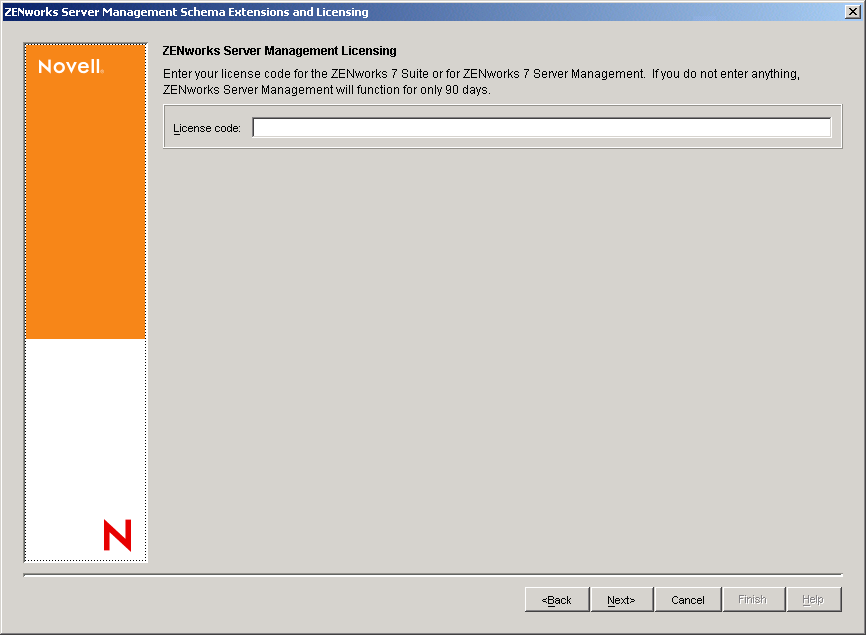
-
Enter a license code, or leave the field blank and click to display the Summary page.
You should have received the license code when you purchased the product. If not, contact Novell, Inc..
If you leave the field blank, the 90-day Evaluation License is in effect. You can enter a license code at a later date. For more information, see Section B.0, Upgrading a 90-day Evaluation License.
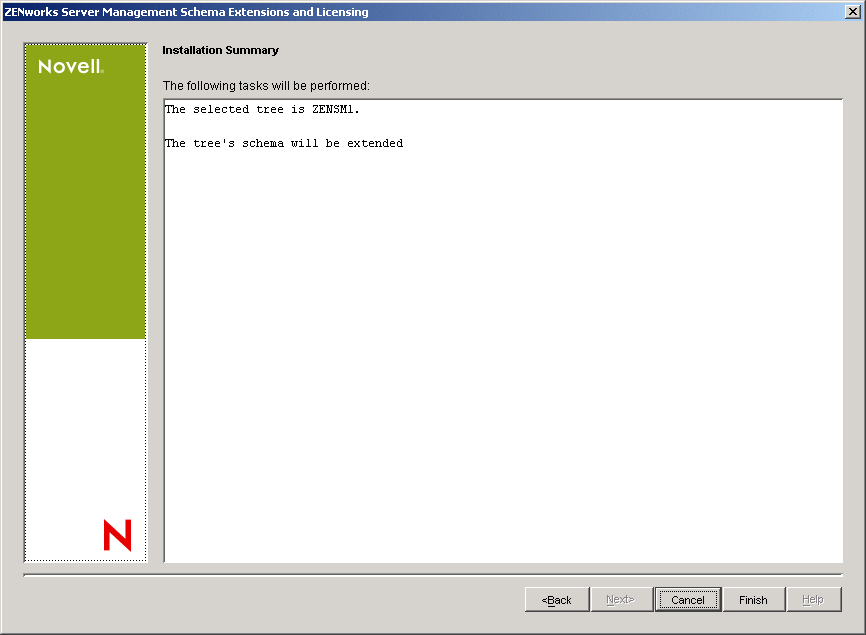
-
To extend the schema, click .
After the schema extension process has completed, the Server Management installation menu is displayed.
-
Continue with Policy-Enabled Server Management.
Policy-Enabled Server Management
Figure 6-2 ZENworks Server Management Installation Menu
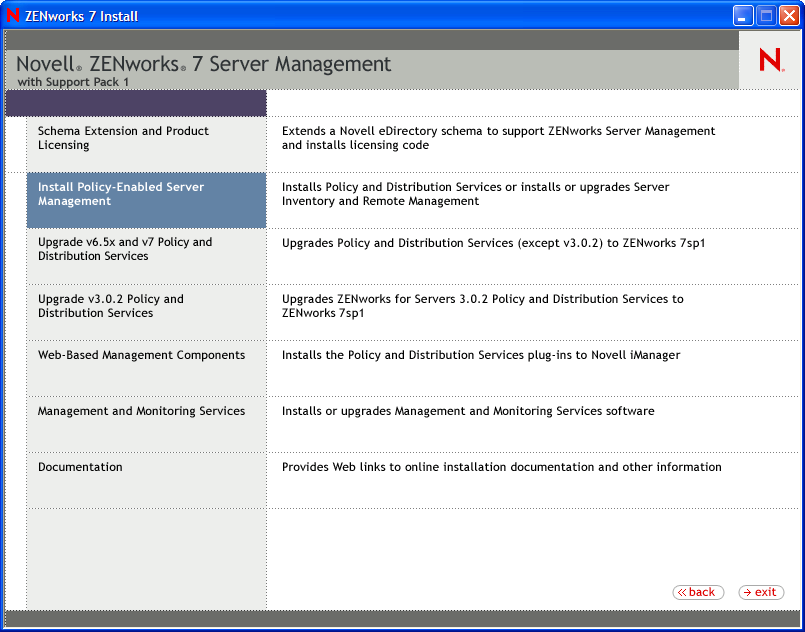
-
Click to start the installation program.
The License Agreement page is the first installation page displayed when the program has loaded.
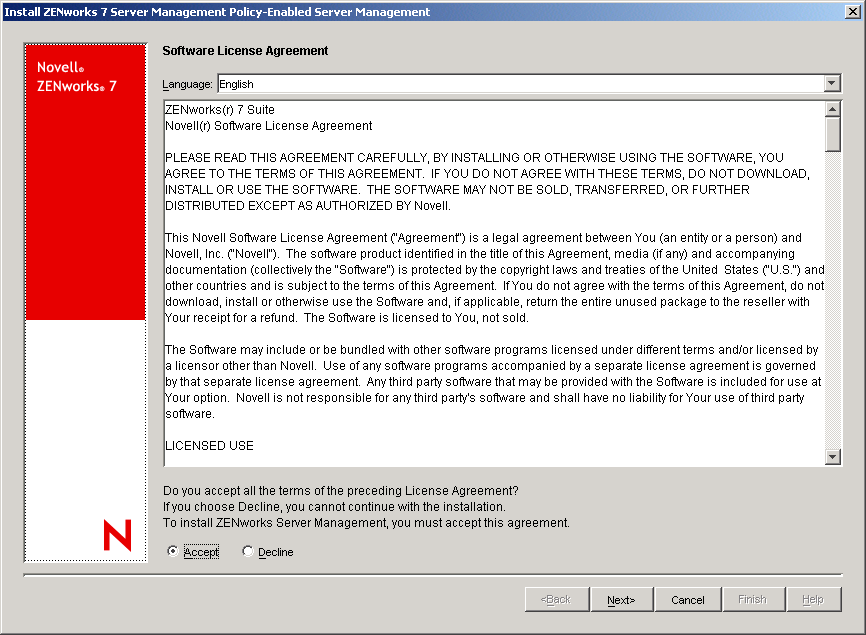
-
If you agree with the Software License Agreement, click > to display the Installation Type page; otherwise, click > to exit.
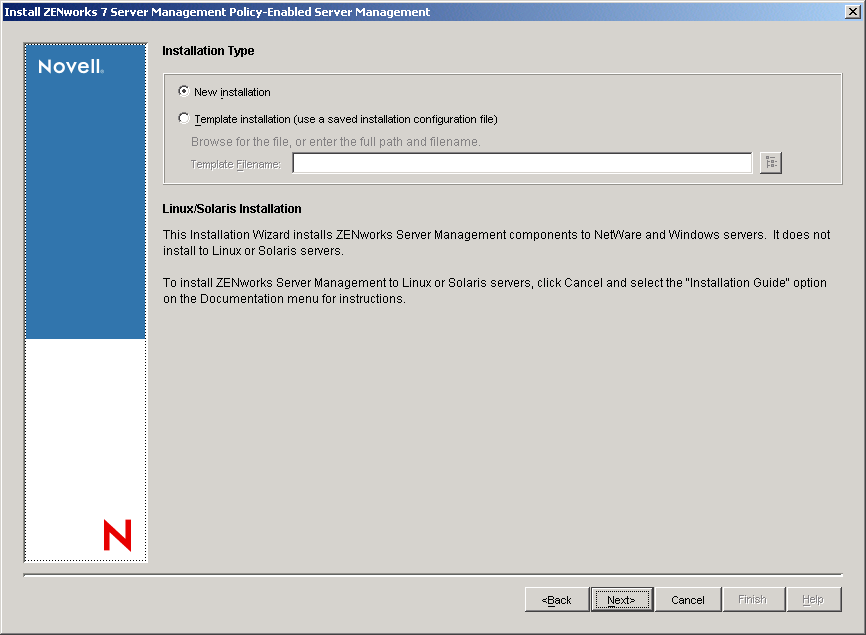
-
On the Installation Type page, click to perform a new installation and display the Installation Options page.
or
To install from a saved installation configuration file, click , browse for or specify the path and filename, then click .
The configuration file populates the remaining wizard pages from the installation settings you previously established when saving the file. This allows you to more quickly rerun the installation when you need to make only a few or no changes to the settings in order to install.
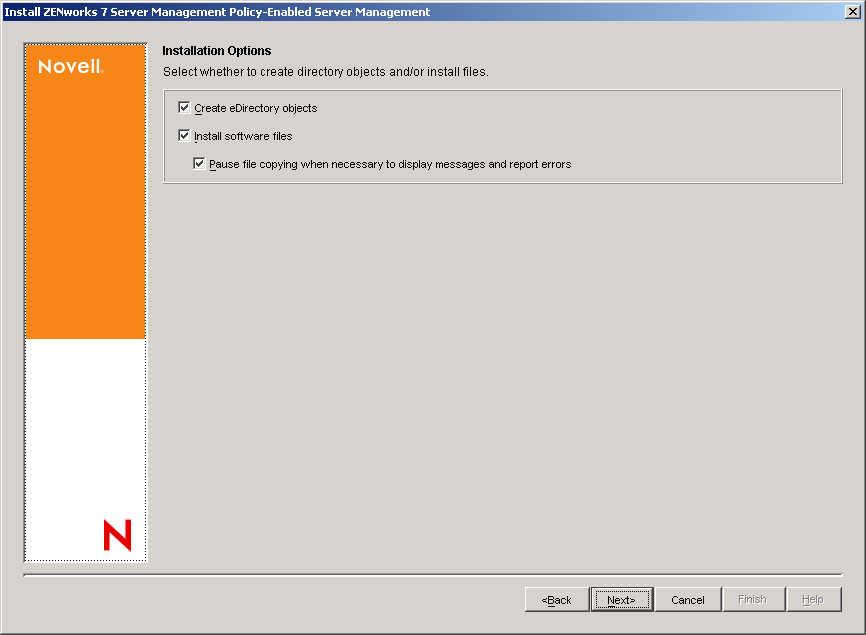
-
On the Installation Options page, click to accept the defaults and display the eDirectory Tree for Creating Objects page, or configure the options, then click .
-
Create eDirectory objects: For a first-time installation, this check box must be selected. Other uses for this option are:
-
Select this check box to reinstall Distributor software. This is required for re-creating the Distributor’s eDirectory object.
-
Select this check box to install additional Subscribers. This creates the Subscriber’s eDirectory object, installs its Subscriber software, and assigns its trusted tree to be the tree that you select in the next installation page.
-
Deselect this check box to only reinstall Subscriber software, such as to a server that already had a Subscriber object created for it.
-
Deselect this check box to only install Subscriber software to a server that does not have a server object in any eDirectory tree, such as a Windows server that is in a Microsoft domain. You can identify its trusted tree in a later installation page.
-
Deselect this check box to independently install the ConsoleOne snap-ins, the Inventory Agent, or the Proxy Service. You do not need to access an eDirectory tree to install these items.
-
Select this check box to install or reinstall the Inventory server or Inventory database.
-
-
Install software files: This check box must be selected to install the Distributor or Subscriber software. Other uses for this option are:
-
Deselect this check box when only installing eDirectory objects.
-
Deselect this check box when installing or reinstalling the Inventory server or Inventory database.
-
-
Pause file copying when necessary to display messages and report errors: By default, this check box is selected. Deselect this check box to have an unattended installation; you can check the installation logs later.
-
-
Continue with:
-
eDirectory Tree for Creating Objects, if the check box is selected.
-
Server Selection, if the check box is deselected.
-
eDirectory Tree for Creating Objects
This page is displayed only if you selected the option on the Installation Options page.
Figure 6-3 eDirectory Tree for Creating Objects Page
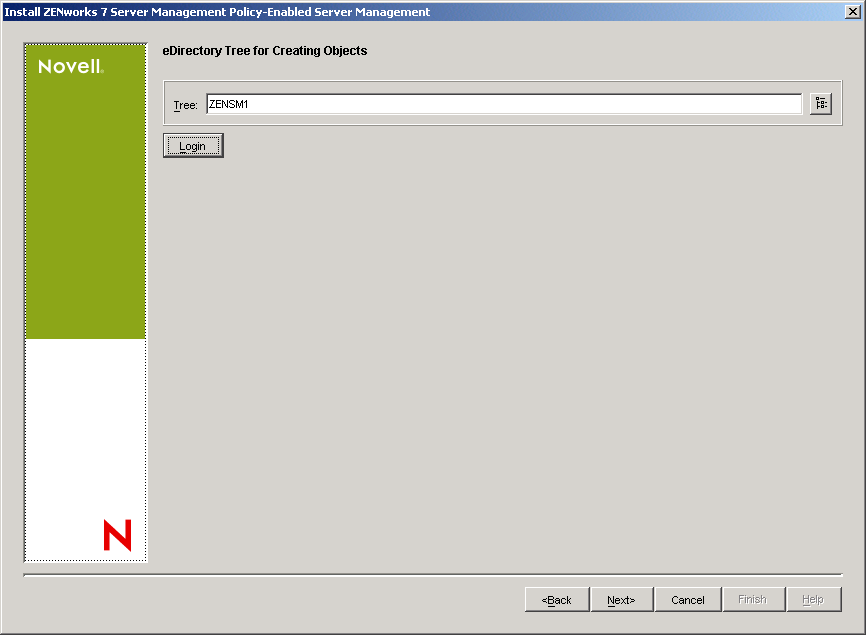
-
Browse for the target tree, click > to display the Server Selection page.
This is the tree where you want the ZENworks objects to be created during installation.
This installation page displays only if you selected installation of ZENworks Server Management objects.
This automatically becomes the trusted tree for all Subscriber servers selected in the next installation page. The trusted tree is where the Subscriber receives its configuration updates.
IMPORTANT:If you selected the check box on the Installation Options page, both NetWare and Windows servers will have eDirectory Subscriber objects created in the tree that you identified in the eDirectory Tree for Creating Objects page. However, if you deselected this check box, you should identify a trusted tree for each Subscriber in the File Installation Paths and Options page.
On the File Installation Paths and Options page, you can create different configurations for different sets of objects. Therefore, you can select objects that might have different installation paths and different trusted trees.
For more information on trusted trees, see
Subscriber Software Configuration and Trusted Trees
in the Novell ZENworks 7 Server Management Administration Guide. -
Continue with Server Selection.
Server Selection
Figure 6-4 Server Selection for Server Management Page
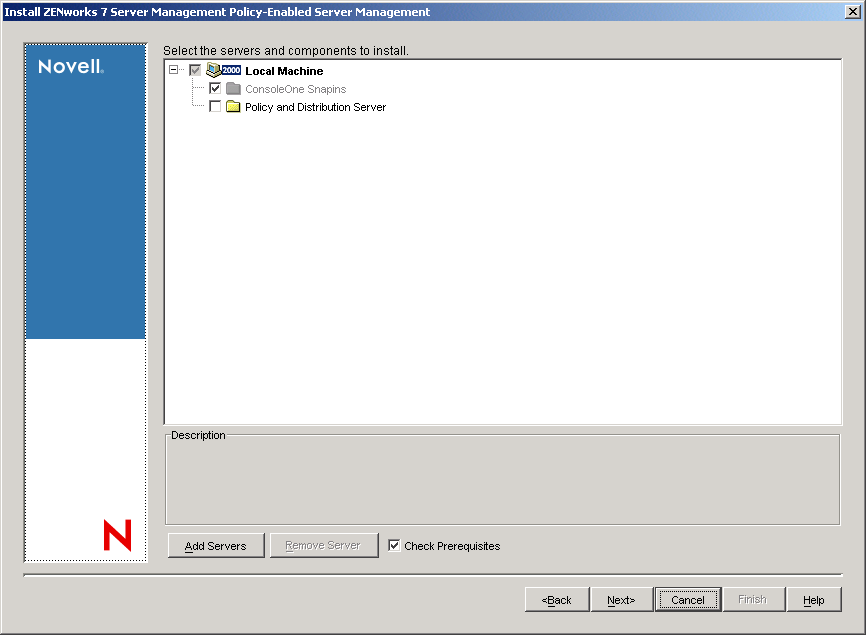
-
On the Server Selection page, if you installed ConsoleOne on your installation machine, enable the check box for the option.
refers to the Windows machine you are using to perform the installation.
Workstation: If is a Windows 2000/XP workstation, you can install the ZENworks Server Management ConsoleOne snap-ins for Policy and Distribution Services, Server Inventory, and Remote Management. You can also install the Policy and Distribution Services Subscriber software to the local machine; however, you cannot install the Distributor software, Server Inventory, or Remote Management to the local machine.
Server: If is Windows 2000 Server (with or without eDirectory installed), you can install the following:
-
ZENworks Server Management ConsoleOne snap-ins for Policy and Distribution Services, Server Inventory, and Remote Management
-
Policy and Distribution Services Subscriber software
-
Remote Management Agent
-
Inventory Agent
-
Inventory Proxy service
-
Inventory database
IMPORTANT:If you choose to install the Inventory database on a server without eDirectory installed, the database objects are not created automatically. You must manually create the database objects. For more information, see
Setting Up the Inventory Database
in the Novell ZENworks 7 Server Management Administration Guide.
The Inventory server can only be installed on a Windows server that also has eDirectory installed.
-
-
On the Server Selection page, click to display the Add Servers dialog box.
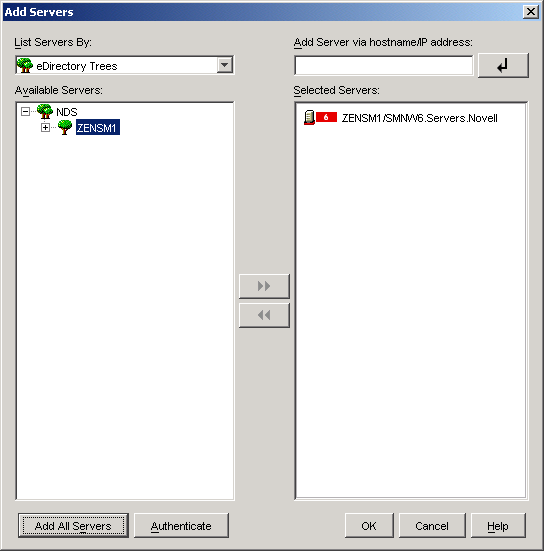
For more information on using the Add Servers dialog box, click its button.
-
Browse for the servers and workstations where you want to install Server Management software, then click .
IMPORTANT:You cannot add a cluster object using this field, or you will receive an “Unknown Host” error. Instead, add cluster objects by browsing for the objects and adding them into the Available Servers list box.
The selected machines are displayed below the option on the server selection page.
Add Servers dialog box: The option displays the Add Servers dialog box, where you can browse for both NetWare and Windows servers and Windows workstations by selecting either NetWare trees or Microsoft domains from a drop-down box. You can select machines individually or in multiples (using Ctrl and Shift). You can also select groups of machines by selecting eDirectory containers, Windows workgroups, and Microsoft domains.
-
To install to a Windows server or workstation that does not have the Novell Client running on it (and therefore you cannot install to it locally), browse for and select this Windows server or workstation so that you can include it separately in the list for installing ZENworks.
-
The Inventory server can only be installed on a Windows server that also has eDirectory installed.
-
You can choose to install the Inventory database on a server that does not have eDirectory installed, but the database objects are not created automatically. You must manually create the database objects. For more information on how to manually create the database objects, see the Novell ZENworks 7 Server Management Administration Guide.
-
Make sure you have selected all of the NetWare and Windows servers and workstations before exiting the Add Servers dialog box.
-
Also browse for the workstations where you want the ConsoleOne snap-ins installed. You must have previously installed ConsoleOne to each of these workstations.
IMPORTANT:If you choose to remotely install the Inventory Agent or the Remote Management Agent on Windows Server 2003 configured as Domain Controller, you must specify the hostname or the IP address of the server in the field.
External Subscribers: The installation program requires an eDirectory context for placing Subscriber objects. If you add a Windows server or workstation from a Microsoft domain that does not have an eDirectory object, in another installation page you are asked to browse and select an eDirectory context where the Subscriber object can be created and associated with the Windows server or workstation.
However, if you intend for this Windows machine to be used only as an External Subscriber, do not install the Subscriber object and software at this time. Instead, you can later install the Subscriber software locally on that machine (which does not have a Subscriber object), then create the External Subscriber object for it in ConsoleOne. For more information on External Subscribers, see
External Subscribers
in the Novell ZENworks 7 Server Management Administration Guide. -
-
Configure each server and workstation listed on this page.
You can configure a group of selected servers with the same options by selecting the group and right-clicking the group. This displays the Custom Selection dialog box illustrated below:
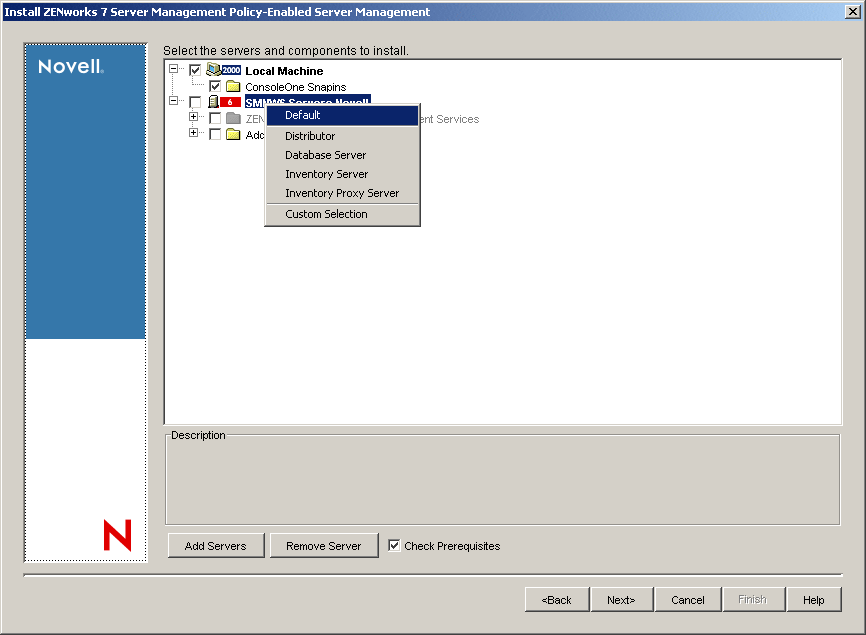
When you select a role for the group, it applies to each server where it’s applicable. Repeat selecting groups and roles as necessary.
You cannot configure a group of selected workstations by selecting the group and right-clicking the group. The Custom Selection feature only works for servers.
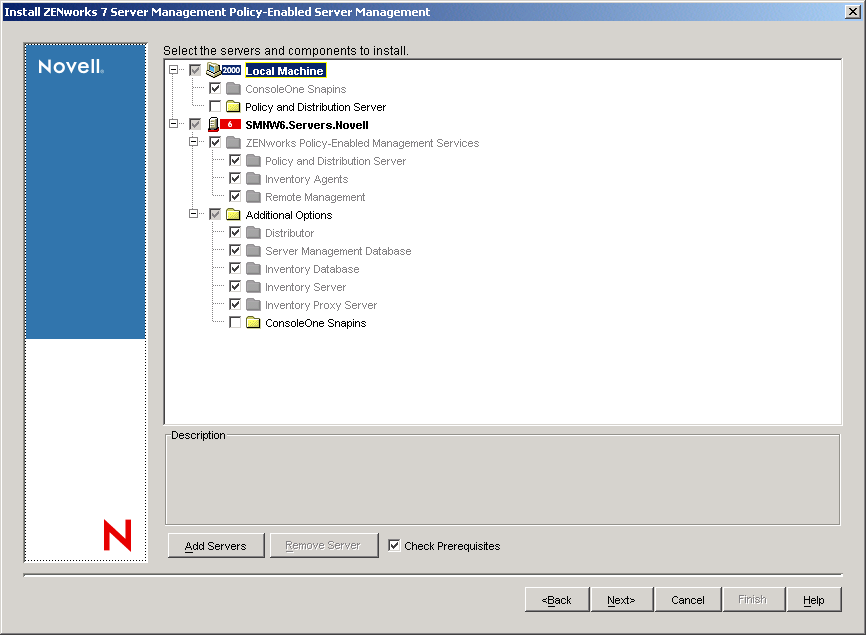
The following options are available for each server listed, as shown above. (Workstations only have the and options available.)
ZENworks Policy-Enabled Management Services
The following three options are all selected by default:
-
Policy and Distribution Services server: Select this check box for each server and workstation that you want to be a Subscriber.
-
Inventory Agents: Select this check box for each server that you want to inventory.
If you want to install the Inventory Agent, you must also select the option.
-
Remote Management: Select this check box for each server that you want to remotely manage.
Additional Options
The installation program detects whether these options are already installed on a target server and dims the option label. You can still select the check box to reinstall the component.
-
Distributor: The Subscriber service is installed automatically to all target servers. Select this check box to also make a server a Distributor.
-
Server Management database: This is the Policy and Distribution Services database that the Distributor logs to. You should install it on the same server as the Distributor in order to minimize network traffic for database logging.
IMPORTANT:You can install the database to multiple servers per run of the installation program; however, you can only install one database per server. On the Database Settings page, you are able to individually configure each database that is being installed. On the Database Logging page, you can identify which of the databases being installed is to be the one database for initial logging.
-
Inventory database: Select this check box for the servers where you want to install the Inventory database to run on Sybase.
IMPORTANT:If you want to use the Inventory database with an existing Oracle or MS SQL setup, do not select this option during the Server Inventory installation. Follow the steps in
Setting Up the Inventory Database
in the Novell ZENworks 7 Server Management Administration Guide. -
Inventory server: Select this check box for the server where you want to run the Inventory services.
WARNING:If you choose to install on servers in which you have logged into but which do not reside in the tree you have selected in Step 1, the installation program proceeds and creates eDirectory objects in the tree having the server.
-
Inventory Proxy server: Select this check box for the servers where you want to install and configure an XML Proxy server.
If you want to send or roll up the scan data to an Inventory server that is across the firewall, you must configure a NetWare or Windows server to run the XML Proxy service.
-
ConsoleOne snap-ins: For any server where you installed ConsoleOne, enable this check box.
IMPORTANT:ZENworks Server Management does not support using a server’s console to run an instance of ConsoleOne installed on that NetWare server. To use the server’s installation of ConsoleOne, you must map a drive from a workstation to that server and run ConsoleOne from the workstation.
-
-
When you have finished configuring the selected machines, click to display the File Installation Paths and Options page.
If you have invalid DNS names, you could receive an error message asking whether to continue installing using IP addresses. Either fix the DNS name problems, or continue by using IP addresses for the affected machines. For information on configuring DNS, see Section D.0, Ensuring Successful DNS Name Resolution.
IMPORTANT:1) During installation, ZENworks Server Management updates .ncf files with installation path information. Because NetWare uses a DOS code page instead of a Windows code page, double-byte or extended characters cannot be used in paths, or the .ncf files do not execute. Therefore, do not use double-byte or extended characters in any part of an installation path, including a NetWare volume name.
2) If you continue with only IP addresses, you must manually enter the correct DNS hostname on the tab in the server object’s properties for each server in order to use Server Management.
-
Continue with File Installation Locations and Options.
File Installation Locations and Options
This page is displayed only if you chose the option for one or more machines. This includes Policy and Distribution Services, Server Inventory, and Remote Management.
Figure 6-5 File Installation Paths and Options Page
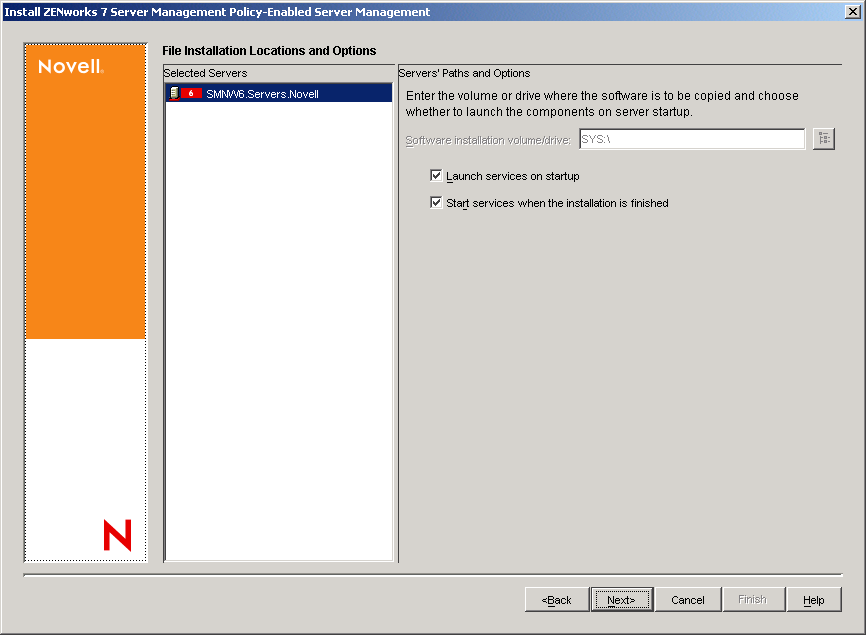
-
Click to accept the defaults on the File Installation Locations and Options page, or configure the following fields, then click to display the Distributor Object Properties page.
Software installation volume/drive: If you change the beginning of the path to a different volume or drive, then all subsequent paths displayed in the installation program automatically matches your change.
IMPORTANT:Do not use double-byte or extended characters in any part of an installation path, including a NetWare volume name.
Each field on this page is configurable per machine. You can make configuration changes machine by machine, or select multiple machines and make the same configuration changes to all of them. For example, you might want the same installation volume for all of your NetWare servers.
Trusted tree: If you deselected installation of eDirectory objects for ZENworks Server Management, an empty field is displayed and must be filled in.
When you install the Subscriber software to a machine in another tree or in a Microsoft domain, and you do not want to create a Subscriber object in your Distributor’s tree, you must identify the trusted tree for the Subscriber.
The trusted tree has two purposes:
-
To locate a Distributor that can give the Tiered Electronic Distribution configuration information to the Subscriber
-
To indicate which tree to accept policies from
If you do not select a tree to be recognized as the Subscriber’s trusted tree during installation of only the Subscriber software (no object installation), your Policy Package Distributions cannot extract and be enforced on that Subscriber, because policies often point to objects in a tree.
Launch Policy and Distribution Services on startup: Leave this check box selected to have the installation program configure the startup processes to automatically launch Policy and Distribution Services any time a server is started.
Start services when the installation is finished: Leave this check box selected, because the Subscribers’ passwords are reset when the service starts.
-
-
Continue with the applicable section for the installation page that is displayed next:
Distributor Object Properties
This page is displayed only if you chose the option for one or more servers.
Figure 6-6 Distributor Object Properties Page

You can change the default settings for Distributors individually, or in groups by selecting multiple Distributors listed in the left pane.
To change the defaults for any of the Distributors:
-
Select one or more Distributors in the left pane, then edit the following fields as necessary:
-
Object name: The default Distributor object name includes the server’s name.
IMPORTANT:Do not use double-byte or extended characters in object names.
If you want to rename the Distributor objects, we recommend that you maintain the servers’ identities in their names, including the fact that they are Distributors.
To rename each Distributor object, you need to repeat Step 1, because you cannot give the same object name to multiple Distributors.
-
Container: The location of the Distributor server’s NCP Server object is the default.
We recommend that you use the containers that you may have created for Distributor objects (see Section 3.3, eDirectory Container Requirements).
Where eDirectory is not installed on a Windows server, that server will not have a default container object displayed. You must select a container for the Distributor object.
-
Working directory: For NetWare servers, the default working directory is on the sys: volume.
If you change any part of the default path, such as a directory name, and that new entry does not yet exist on the server, the Distributor creates that new path the first time it needs to use it.
The default volume on a NetWare server is sys:. If the working directory has the potential to become quite large because you expect to have many very large Distributions and/or many revisions of large Distributions for this Distributor, we recommend that you specify a different volume. However, for most Distributors, you can retain the sys: volume.
-
-
Repeat Step 1 for each different Distributor or set of Distributors.
-
Click to display the Subscriber Object Properties page.
-
Continue with the applicable section for the installation page that is displayed next:
Subscriber Object Properties
This page is displayed only if you chose the option for one or more machines.
Figure 6-7 Subscriber Object Properties Page
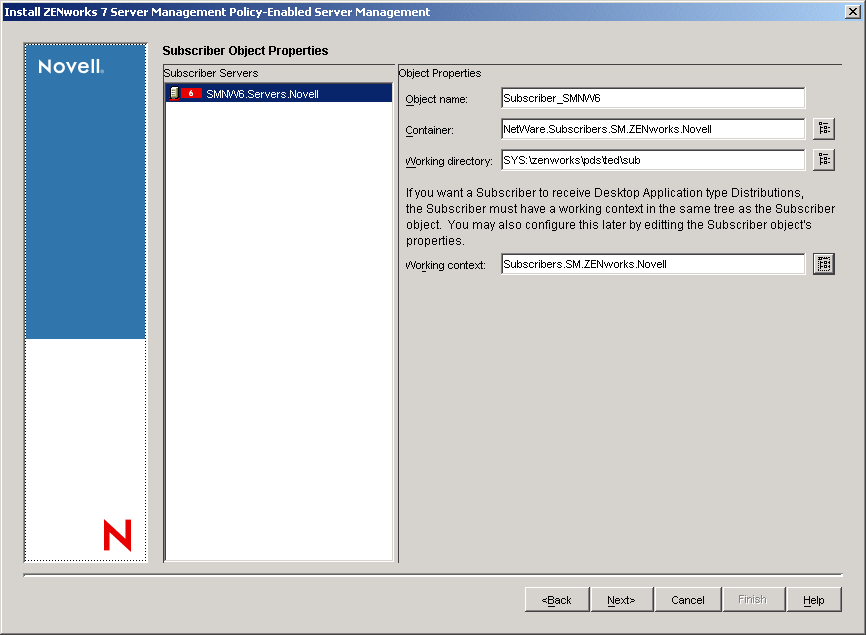
You can change the default settings for Subscribers individually, or in groups by selecting multiple Subscribers listed in the left pane.
To change the defaults for any of the Subscribers:
-
Select one or more Subscribers in the left pane, then edit the following fields as necessary:
-
Object name: The default Subscriber object name includes the server’s or workstation’s name.
IMPORTANT:Do not use double-byte or extended characters in object names.
If you want to rename the Subscriber objects, we recommend that you maintain the servers’ or workstations’ identities in their names, including the fact that they are Subscribers.
To rename each Subscriber object, you need to repeat Step 1, because you cannot give the same object name to multiple Subscribers.
-
Container: The location of the Subscriber server’s NCP Server object is the default. If you select a workstation for installing Policy and Distribution Services (the Subscriber software), this field is blank for the workstation.
If you have created containers for Subscriber objects, we recommend using these containers (see Section 3.3, eDirectory Container Requirements).
For ease of management, you should use the same context for all Subscriber servers of the same operating system type. For example, place all NetWare Subscriber servers’ objects under a NetWare container and all Windows Subscriber servers’ objects under a Windows container.
Where eDirectory is not installed on a Windows server, that server does not have a default container object displayed. You must select a container for the Subscriber object.
-
Working directory: If you change any part of the default path, such as a directory name, and that new entry does not yet exist on the server, the Subscriber creates that new path the first time it needs to use it.
For NetWare servers, the default working directory is on the sys: volume.
-
Working context: If you anticipate Desktop Application Distributions will be received by a Subscriber, browse for where you want related objects to be stored.
You can add a working context later in ConsoleOne for any Subscriber that receives Desktop Application Distributions.
-
-
Repeat Step 1 for each different Subscriber or set of Subscribers.
-
Click to display the Database Settings page.
-
Continue with the applicable section for the installation page that is displayed next:
Database Settings
This page is displayed only if you chose to install the Policy and Distribution Services database (the option) or the Server Inventory database (the option) on a server.
Figure 6-8 Database Settings Page
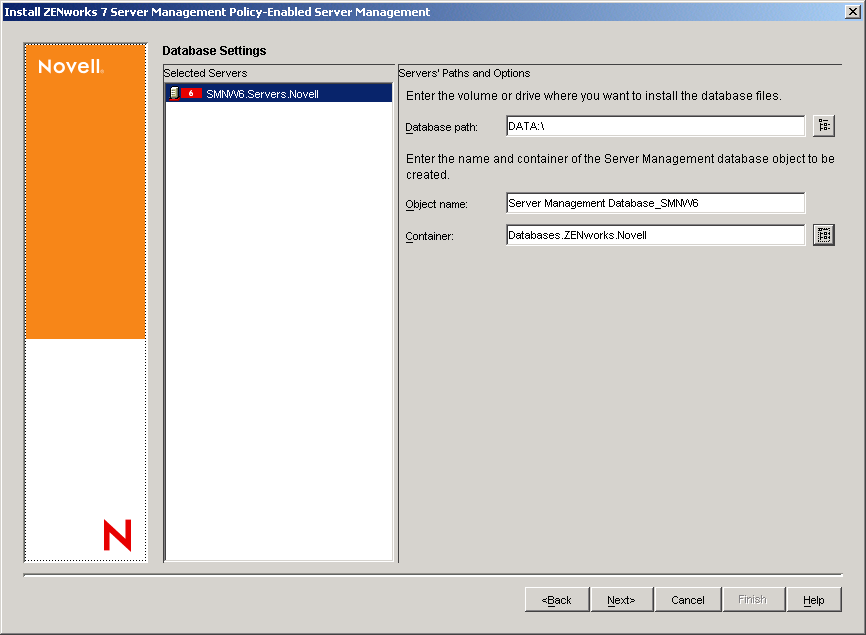
-
Click to accept the defaults, or for each database being installed, edit the applicable fields:
HINT:You can multiple-select databases to provide the same information for each of them.
Database path: The default for NetWare servers is sys: and for Windows servers is C:. You can change either of these defaults.
IMPORTANT:We strongly recommend that for the Server Management database on NetWare servers, you change sys: to another NetWare volume, because database files can become very large.
Object name: The default name is Server Management Database_server_name, which you can change. However, if you select the same container for all database objects, each must have a unique object name.
A database object is not created for the Server Inventory database.
Container: The default container is where the server’s NCP Server object resides. We recommend that you use the container that you created for database objects in Section 3.3, eDirectory Container Requirements.
For ease of management, we also recommend that you place all database objects in the same container.
-
Click and continue with the applicable section for the installation page that is displayed next:
Inventory Standalone Configuration
This page is displayed only if you chose to install Inventory Server and the Inventory Database on the same server.
Figure 6-9 Inventory Standalone Configuration Page
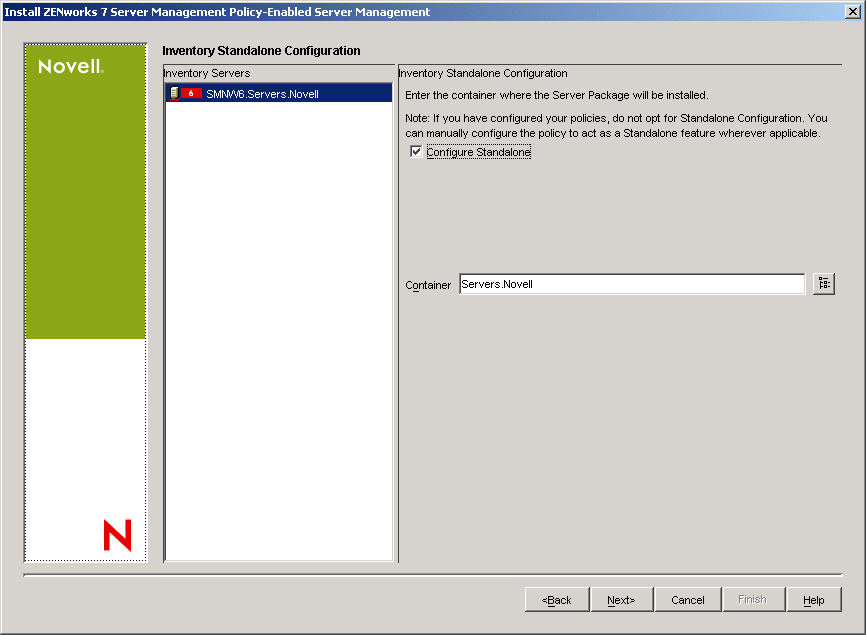
-
To automatically create the Server Package and start the Inventory Services, click the box to enable it.
You can select one or more Inventory servers in the left pane to have the same configuration.
IMPORTANT:If you have already configured Server Package policies for these servers, do not enable the check box. You can manually configure the policy to act as a standalone feature wherever applicable.
-
To specify the container for the Server Package object, browse for and select the container.
You can select one or more Inventory servers in the left pane to assign the same container for creating the Server Package.
-
Continue with the applicable section for the installation page that is displayed next.
Inventory Proxy Service Configuration
This page is displayed only if you chose the option for one or more servers.
Figure 6-10 Inventory Proxy Service Configuration Page
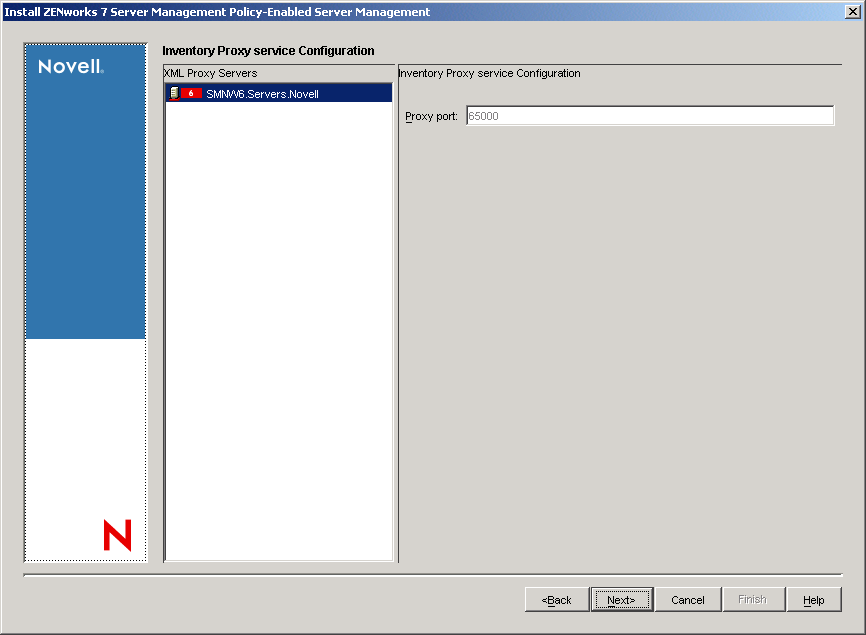
-
To configure the port number of the Inventory Proxy service, if you do not use the default port of 65000, specify the port number in the field.
You can select one or more Inventory Proxy servers in the left pane to assign the same port number.
You must specify a value between 0 and 65535. Ensure that the port number is not used by other services on the server.
-
Continue with the applicable section for the installation page that is displayed next.
Remote Management Configuration
This page is displayed only if you chose the option for one or more Windows servers.
Figure 6-11 Remote Management Configuration Page
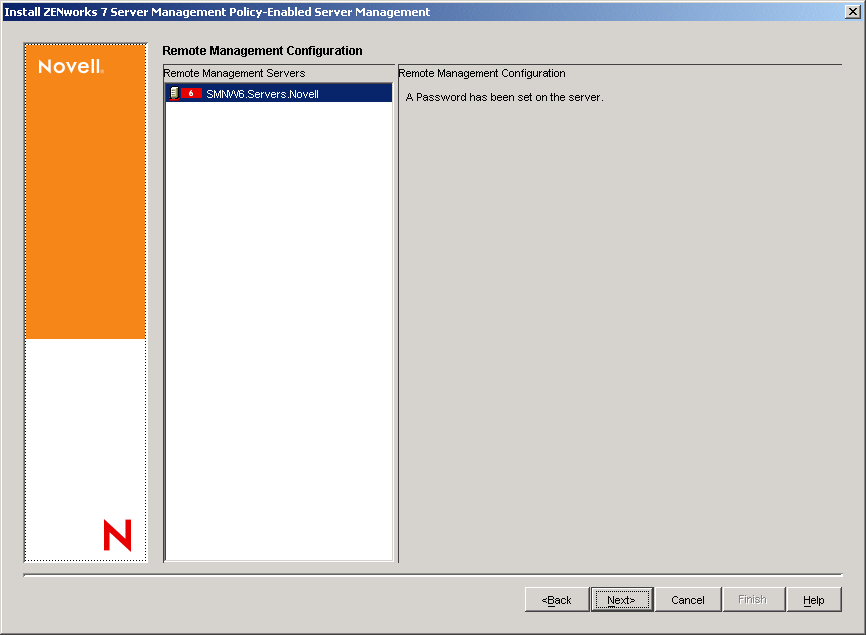
Use this dialog box to configure the password for the Remote Management Agent and install Mirror Driver on the managed server. You can either use the default password or specify a password.
-
To set the default password for the Remote Management Agent, select the check box. The default password is “novell.”
-
To use a password other than the default password, specify another password in the field.
If a previous installation of ZENworks 7 Remote Management Agent is detected on the machine and a password is set, the field is not displayed.
This password is used for establishing a Remote Management session with the managed servers.
Use a password of ten or fewer ASCII (non-extended) characters. The password is case sensitive and cannot be blank. You can choose to proceed without specifying any password, but you will not be able to establish the Remote Control session with the server.
-
You can install Mirror Driver only if your target server is a Windows 2000/2003 server. The option provides video adapter independence and coexistence with other Remote Control solutions. If this check box is selected, InstallShield overrides video driver checks and suppresses any Windows messages. If you do not want this driver, you can deselect it (optimization is disabled).
IMPORTANT:Mirror Driver is not yet signed by Microsoft.
-
Continue with the applicable section for the installation page that is displayed next:
Policy and Distribution Services Database Logging
This page is displayed if you chose to install the Policy and Distribution Services database (the option) on a server, or if you are installing Policy and Distribution Services on a workstation, because its Subscriber needs to know where to log its information to.
This page eliminates the need to configure a ZENworks Database policy (in the Service Location Package) for the Distributor being installed, so that Server Management can begin logging to a database immediately after installing. At your convenience after installation, you can set up any other installed databases by configuring Service Location Packages for each of them so that they can be used by their Distributors.
Figure 6-12 Policy and Distribution Services Database Logging Page
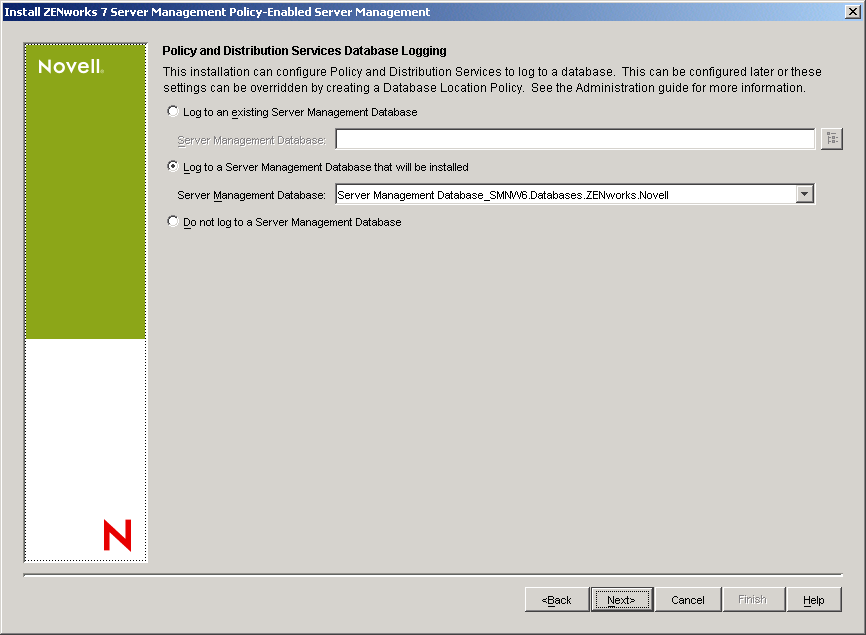
-
To determine logging for a Server Management database that you configured in a previous installation page, select one of the following:
Log to an existing Server Management database: Select an existing database file for logging by browsing for and selecting the database object, rather than log to one of the databases being installed.
Log to a Server Management database that will be installed: One of the database objects that you configured in a previous installation page is displayed. However, you can select a different database object that is being installed by clicking the down-arrow. This option is not available for a workstation installation of the Subscriber software.
Do not log to a Server Management database: You can elect to not log to a database at this time, even though you have configured a database in the previous installation page.
-
Click to continue with Installation Summary.
Installation Summary
Figure 6-13 Installation Summary Page
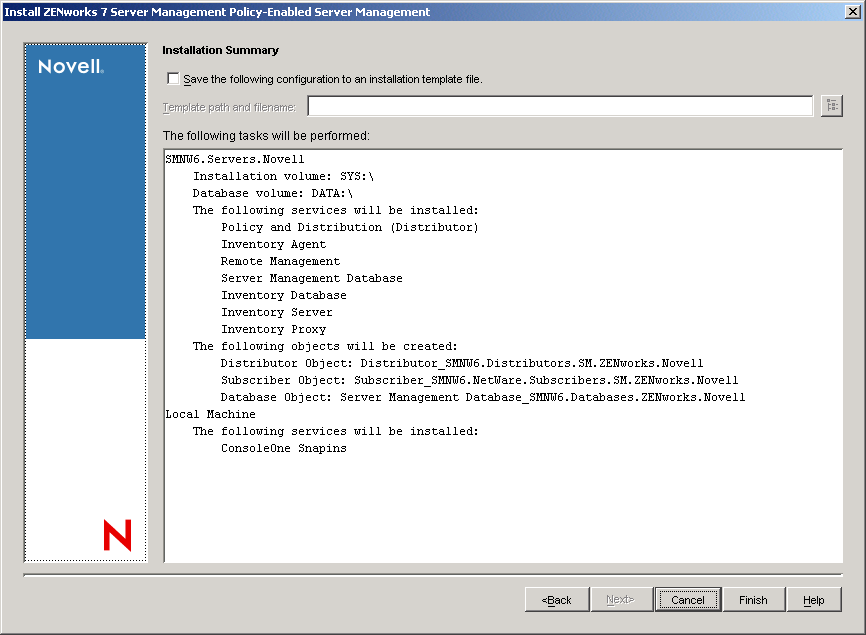
-
To save the current installation configuration for future use, click the check box, then specify a path and filename for the template file.
You can use this template file to repeat the ZENworks Server Management installation. It can save time in re-entering information and re-selecting servers and workstations. When you rerun the installation using a template, you can make changes to the fields and selected servers and workstations in the installation pages that are populated by the template.
-
On the Installation Summary page, click to begin the installation process.
You can click to make changes if you discover errors or omissions in the summary.
-
After the installation program has finished, review the installation log file to determine whether any components failed to install.
The log file is located in the installation machine’s temporary directory as determined in its Windows environment settings. For example:
c:\temp\_resnnn.txtwhere nnn is increased incrementally each time a new installation log is created.
If you receive error messages during installation, see Section H.0, Installation Error Messages.
-
If necessary, rerun the installation program.
Select only the components that failed to install.
A reinstallation does not require the schema to be extended again.
-
After successfully installing the software, click to close the main installation program.
At this time, Server Management objects have been created, the software is installed, and the Server Management agents should be starting.
-
To verify that the ZENworks processes are running, continue with Verifying That the Policy and Distributions Services Agents Are Loaded.
The following NetWare registry entries are made in \\my server\software\novell\ZENWORKS\zfs\:
- PDS
- PDSDB
- Inventory Database Server
- RconsoleJ Agent for NetWare
- Inventory Server
- Inventory Agent
Verifying That the Policy and Distributions Services Agents Are Loaded
To verify that the Policy and Distributions Services agents are running on the target servers and workstations:
Verifying on NetWare Servers
To verify if ZENworks Server Management is running properly on a NetWare server:
-
On the target server’s console, press Ctrl+Esc to view the loaded software programs, such as:
- ASA 8.0.3 ...
- ZENworks (if Policy and Distribution Services is installed)
- ZENworks Inventory Service
- ZENworks Web Server (if only Inventory Server or Inventory Proxy Service is installed)
-
If the ZENworks service is not displayed, review the following file:
\zenworks\zfs-startup.log
This file contains information about why the agent did not start. Use this information to reinstall ZENworks Server Management to the server.
This file is used to log startup problems only.
-
If necessary, rerun the installation program (see Starting the Installation Program).
-
Continue with the next applicable section:
-
If you have installed to Windows servers, continue with Verifying on Windows Servers and Workstations.
-
To install the Policy and Distribution Services plug-ins for iManager, continue with Section 6.1.2, Web-Based Management for Policy and Distribution Services.
-
Or, continue with Section 6.4, Post-Installation Tasks.
-
Verifying on Windows Servers and Workstations
To verify if ZENworks Server Management is running properly on a Windows server or workstation:
-
On the target server or workstation, open the Control Panel, double-click > , then determine if the following services are running:
- Novell Inventory Service
- Novell Database - Sybase
- Novell ZENworks Service Manager 1
1 This is the only service to look for where you have installed the Subscriber software on a workstation.
-
If the services are not displayed, do the following:
-
Close the Services window.
-
Click > , then enter the following command:
zenworks\pds\bin\dservices.bat
This stops the ZENworks Server Management services and unregisters them. This is done to make sure a clean state exists for registering the services.
-
Click > , then enter the following command:
zenworks\pds\bin\sservices.bat
This registers the ZENworks Server Management services.
-
Open the Control Panel, double-click > , then start the services by right-clicking each one and selecting .
-
-
Repeat Step 1 and Step 2 for each Windows server or workstation.
-
If necessary, rerun the installation program (see Starting the Installation Program).
-
Continue with the next applicable section:
-
To install the Policy and Distribution Services plug-ins for iManager, continue with Section 6.1.2, Web-Based Management for Policy and Distribution Services.
-
Or, continue with Section 6.4, Post-Installation Tasks
-
6.1.2 Web-Based Management for Policy and Distribution Services
You can use Novell iManager 2.0.2, 2.5 or 2.6 in addition to ConsoleOne 1.3.6 to make some Tiered Electronic Distribution administration and agent monitoring tasks easier. iManager enables you to perform Policy and Distribution Services tasks from any location where a supported version of Internet Explorer or Mozilla Firefox is available.
Using iManager, you can:
-
Create, modify, and delete Tiered Electronic Distribution objects (Distributor, Subscriber, Distribution, Channel, Subscriber Group, and External Subscriber).
-
View a graphical representation of your distribution system, which makes it easy to track a Distribution from Distributor to end node Subscriber, no matter how many parent Subscribers the Distribution passes through. This eliminates the need to visit each server or to read log files.
-
Display a browser-based console, called the Remote Web Console, for each Distributor Agent and Policy/Package Agent in your system. From the Remote Web Console, you can review the configuration of any agent, monitor the activities of any agent, and control many agent functions, such as forcing an action on a Distributor, Subscriber, or Policy Package to happen immediately, or monitoring the status of a Distribution, Subscriber, or Policy Package.
The iManager plug-ins shipped with ZENworks 7 work with iManager 2.0.2, 2.5, and 2.6.
To install Novell iManager 2.6, see Section 4.3, Management-Specific Workstation Requirements.
The processes for installing the iManager plug-ins is different for iManager 2.0.2 and iManager 2.5 or 2.6 in ZENworks 7 with SP1 and earlier:
-
Installing the Plug-ins to iManager 2.0.2
IMPORTANT:If you installed iManager to a Linux or Solaris server, you can use this GUI installation program to install the Policy and Distribution Services plug-ins to iManager on the Linux or Solaris server.
Installing the Plug-ins to iManager 2.0.2
To install the Policy and Distribution Services plug-ins for iManager:
-
Make sure that Tomcat and iManager are loaded on the server where you install the plug-ins.
If these processes are not running on this server, the authentication performed when clicking in Step 5 fails.
-
Do one of the following to display the main installation menu:
-
On the installation machine, insert the Novell ZENworks 7 Server Management with Support Pack 1 Program CD.
The startup page is displayed. If the startup page is not automatically displayed after inserting the CD, run winsetup.exe at the root of the CD.
-
If you copied the contents of the Program CD to a hard drive, run winsetup.exe from that hard drive location.
If you copied the Program CD structure to the installation machine’s hard drive, the path between the root of the hard drive and the first CD directory can contain only directory names that conform to the 8.3-character DOS file naming convention. If any long directory names exist in the path, the installation program does not work.
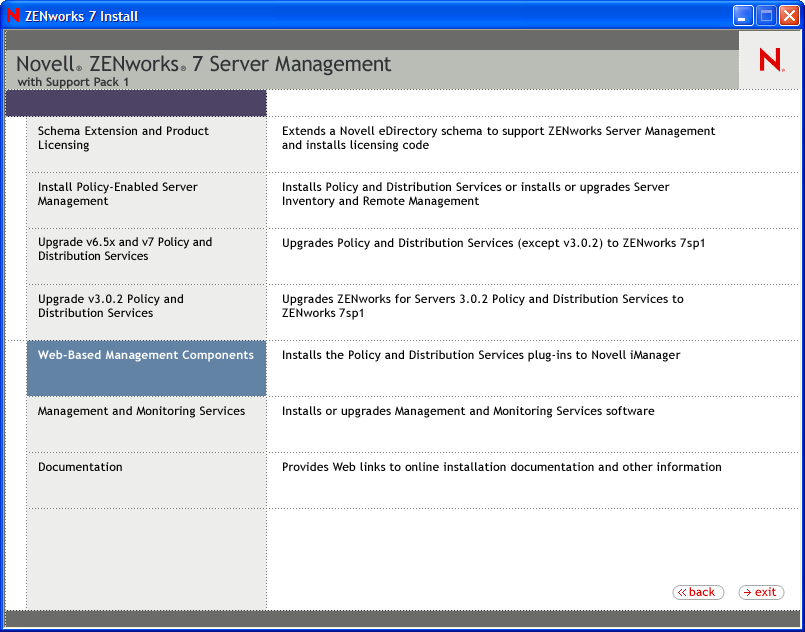
-
-
Click to display the License Agreement page.
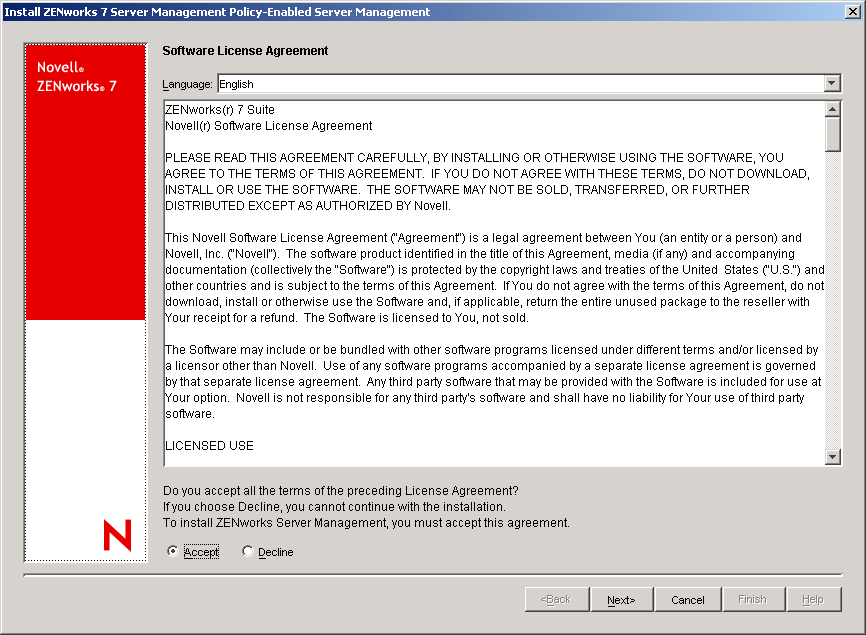
-
Accept the License Agreement, then click to view the Login Information page.
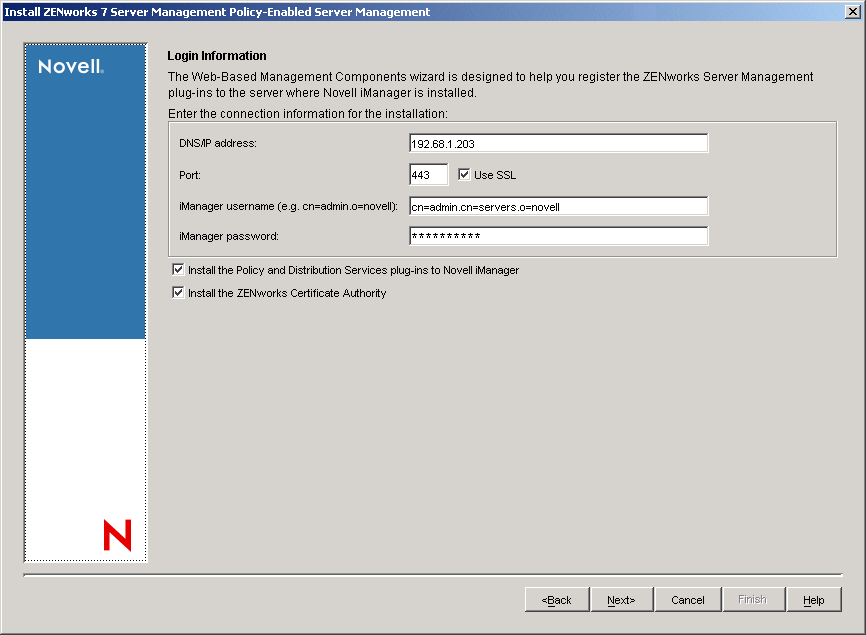
-
Fill in the fields:
IMPORTANT:Tomcat and iManager must be loaded on the specified server in order for authentication of the following information to succeed.
DNS/IP address: Specify the address of the server where iManager is installed.
Port: Specify the port number to use when communicating with iManager. It will most likely be 443 if SSL is used; if not, use 8080.
Use SSL: By default, this check box is not selected. If you have iManager configured to use SSL, you should enable this check box.
iManager username: Specify the iManager (fully-distinguished) login name of the user with rights to iManager. This must be entered in the format indicated (for example, cn=admin.o=novell). Installation cannot continue if the username does not authenticate.
iManager password: Specify the iManager password of the user running the installation program.
Install the Policy and Distribution Services plug-ins to Novell iManager: Select the check box to install the Remote Web Console and Tiered Electronic Distribution plug-ins to iManager so that you can manage these components from a Web browser.
Install the ZENworks certificate authority: Select the check box to install the ZENworks certificate authority servlet for inter-server communications security. This provides additional security to ensure that data received from outside your secured network is from a trusted source, that it has not been tampered with en route, and that the data received can be trusted by other machines. This is accomplished through the use of signed security certificates and digital signatures.
-
Click to view the Summary page.

The installation summary indicates that the selected Web components are installed to the Tomcat installation directory.
-
Click .
-
When the installation has completed, click to view the installation log file.
If the log file contains errors, you can print it for reference. To look up error messages, see Section H.0, Installation Error Messages. Correct the error, then repeat the installation steps.
The ZENworks Server Management role in iManager should still be set up, because the information for it is stored in eDirectory.
To reinstall the Novell Certificate Signer, follow the instructions in the Novell ZENworks 7 Server Management Administration Guide.
-
After successfully installing the iManager plug-ins, close the log file.
-
For iManager to recognize the new plug-ins, stop Tomcat, then restart Tomcat:
-
NetWare
Stop: tc4stop.ncf
Start: tomcat4.ncf
-
Windows
In the Services window, start or stop the Tomcat service by right-clicking the service and selecting the option.
-
Linux
Restart: /etc/init.d/tomcat4 restart
or
Stop: /etc/init.d/tomcat4 stop
Start: /etc/init.d/tomcat4 start
-
OES Linux
Restart: /etc/init.d/novell-tomcat4 restart
or
Stop: /etc/init.d/novell-tomcat4 stop
Start: /etc/init.d/novell-tomcat4 start
-
-
Continue with the next applicable section:
-
If you performed this iManager installation task while upgrading, return to Upgrade the Novell iManager Plug-Ins.
-
To install Policy and Distribution Services (Subscriber only) locally on a Windows workstation, or remotely to several Windows workstations, continue with Section 6.2, Installation on Windows Workstations.
-
To install on Linux or Solaris servers, continue with Section 6.3, Installation on Linux and Solaris Servers
-
If you do not install on Linux or Solaris servers, continue with Section 6.4, Post-Installation Tasks
-
Installing the Plug-ins to iManager 2.5 or 2.6
-
Locate the Novell iManager plug-in module (NPM) on the Novell ZENworks 7 with Support Pack 1 Companion 1 CD:
\Novell iManager\ZFS Plugins NPM\ZFS_PolyDistPlugins.npm
-
Follow the instructions in your iManager documentation to install the NPM:
-
iManager 2.5: see the Novell iManager 2.5 Installation Guide
-
iManager 2.6: see the Novell iManager 2.6 documentation
-
-
Continue with the next applicable section:
-
If you performed this iManager installation task while upgrading, return to Upgrade the Novell iManager Plug-Ins.
-
To install Policy and Distribution Services (Subscriber only) locally on a Windows workstation, or remotely to several Windows workstations, continue with Section 6.2, Installation on Windows Workstations.
-
To install on Linux or Solaris servers, continue with Section 6.3, Installation on Linux and Solaris Servers
-
If you do not install on Linux or Solaris servers, continue with Section 6.4, Post-Installation Tasks
-